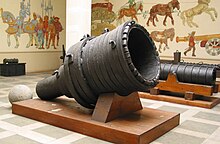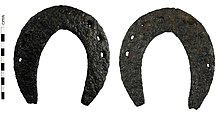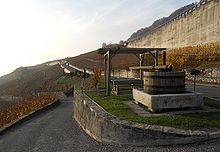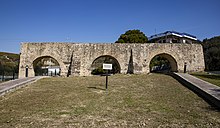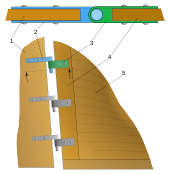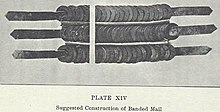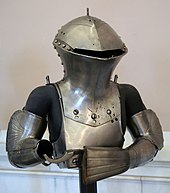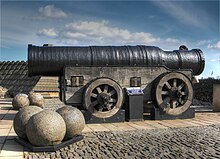Medieval technology
After the Renaissance of the 12th century, medieval Europe saw a radical change in the rate of new inventions, innovations in the ways of managing traditional means of production, and economic growth.
[2] The period saw major technological advances, including the adoption of gunpowder, the invention of vertical windmills, spectacles, mechanical clocks, and greatly improved water mills, building techniques (Gothic architecture, medieval castles), and agriculture in general (three-field crop rotation).
The development of water mills from their ancient origins was impressive, and extended from agriculture to sawmills both for timber and stone.
Many European technical advancements from the 12th to 14th centuries were either built on long-established techniques in medieval Europe, originating from Roman and Byzantine antecedents, or adapted from cross-cultural exchanges through trading networks with the Islamic world, China, and India.
Often, the revolutionary aspect lay not in the act of invention itself, but in its technological refinement and application to political and economic power.
Advances in shipbuilding included the multi-masted ships with lateen sails, the sternpost-mounted rudder and the skeleton-first hull construction.
Technologies were often a matter of cultural exchange and date and place of first inventions are not listed here (see main links for a more complete history of each).
[10] The medieval plough, constructed from wooden beams, could be yoked to either humans or a team of oxen and pulled through any type of terrain.
This allowed for faster clearing of forest lands for agriculture in parts of Northern Europe where the soil contained rocks and dense tree roots.
[20] This system was originally found in middle eastern areas and is still used today in places where surface water is hard to find.
In Reichenau Abbey a network of interconnected underfloor channels heated the 300 m2 large assembly room of the monks during the winter months.
[1] These cranes were placed on docksides for the loading and unloading of cargo where they replaced or complemented older lifting methods like see-saws, winches and yards.
Flemish painter Jan van Eyck developed the use of a stable oil mixture for panel painting around 1410.
Unlike water in a clepsydra, the rate of flow of sand is independent of the depth in the upper reservoir, and the instrument is not liable to freeze.
[31] European cast iron first appears in Middle Europe (for instance Lapphyttan in Sweden, Dürstel in Switzerland and the Märkische Sauerland in Germany) around 1150,[32] in some places according to recent research even before 1100.
[42][43] Vertical windmills (1180s) Invented in Europe as the pivotable post mill, the first surviving mention of one comes from Yorkshire in England in 1185.
The iron hinge system was the first stern rudder permanently attached to the ship hull and made a vital contribution to the navigation achievements of the Age of Discovery and thereafter.
Theory of impetus (6th century) A scientific theory that was introduced by John Philoponus who made criticism of Aristotelian principles of physics, and it served as an inspiration to medieval scholars as well as to Galileo Galilei who ten centuries later, during the Scientific Revolution, extensively cited Philoponus in his works while making the case as to why Aristotelian physics was flawed.
Arabic numerals (13th century) The first recorded mention in Europe was in 976, and they were first widely published in 1202 by Fibonacci with his Liber Abaci.
Chess (1450) The earliest predecessors of the game originated in 6th-century AD India and spread via Persia and the Muslim world to Europe.
Texts on the distillation of waters, wine, and other spirits were written in Salerno and Cologne in the twelfth and thirteenth centuries.
These spirits would have had a much lower alcohol content (about 40% ABV) than the alchemists' pure distillations, and they were likely first thought of as medicinal elixirs.
His Anathomia provides pictures of neuroanatomical structures and techniques such as the dissection of the head by means of trephination, and depictions of the meninges, cerebrum, and spinal cord.
Quilted armour was usually just a jacket made of thick linen and wool meant to pad or soften the impact of blunt weapons and light blows.
[67] Components of medieval armour that made up a full suit consisted of a cuirass, a gorget, vambraces, gauntlets, cuisses, greaves, and sabatons held together by internal leather straps.
This innovation gave birth to true shock cavalry, enabling fighters to charge on full gallop.
In 1350 Petrarch wrote "these instruments which discharge balls of metal with most tremendous noise and flashes of fire...were a few years ago very rare and were viewed with greatest astonishment and admiration, but now they are become as common and familiar as kinds of arms.
Counterweight trebuchet (12th century) Powered solely by the force of gravity, these catapults revolutionized medieval siege warfare and construction of fortifications by hurling huge stones unprecedented distances.
Originating somewhere in the eastern Mediterranean basin, counterweight trebuchets were introduced in the Byzantine Empire around 1100 CE, and was later adopted by the Crusader states and as well by the other armies of Europe and Asia.
[70] Greek fire (7th century) An incendiary weapon which could even burn on water is also attributed to the Byzantines, where they installed it on their ships.
